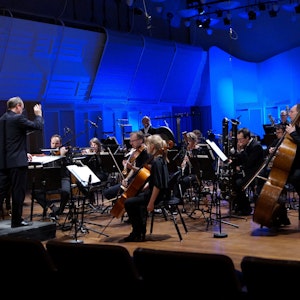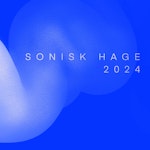Kristine Tjøgersen: Travelling Light (2015)
Kristine Tjøgersen's "Travelling Light II" takes place inside a blender opening, which allows varying amounts of light rays to enter. The sound describes the light, but as I listen, I envision one of Jan Svankmajer's short films. Here, bodies can be human bodies in one moment, and in the next moment, they can be made of wood, vegetables, or plasticine. The instruments flicker back and forth between body and puppet, life and decay.
Jenny Hval
Conlon Nancarrow (1912–1997): Etude No. 6 and No. 7
Nancarrow fought against Franco's forces in the Spanish Civil War and had to emigrate to Mexico when he returned to the USA because he was a communist. He had reportedly composed unplayable instrumental music even earlier in the USA, and in Mexico, the collaboration situation with live musicians did not become any easier. It's likely that this half-voluntary, half-forced exile placed him in such a state of isolation that he could create and explore his new musical universe as a highly eccentric monk. He chose the self-playing piano as a medium for an increasingly rhythmic complex music, meticulously inscribing it by hand on piano rolls. His collection of etudes for pianola could have ended up as one of the curiosities of music history, and perhaps they are, but they have gained extensive significance since György Ligeti brought them attention from the 1980s onwards. The attentive nerd might interject that Frank Zappa was notably inspired by Nancarrow as early as the 1960s.
Nancarrow had a background as a jazz trumpeter, and many of the etudes bear a strong resemblance to jazz genres such as boogie-woogie, blues, and much more, but in highly complex rhythmic constellations. In other etudes, he has more successfully transformed his sources of inspiration into something one might call a kind of unique Nancarrow style.
Etude No. 6 belongs to the first category – here we find an almost habanera-like accompaniment figure in the bass, while blues-like figures alternate with stepwise scale movements in the treble, all done in the ratios 4:5:6, which in most conventional contexts is a rather complex rhythmic constellation. Precisely because the musical material is relatively straightforward and on one level simple, it's quite easy to follow the different rhythmic layers.
In Etude No. 7, the impulses have been combined in a way that makes it feel like a piece in Nancarrow's style rather than a conglomerate of jazz styles. The material is still relatively simple, with triads and scales, but it's all fused together in a way that makes it sound unmistakably like Nancarrow and nothing else. The piece has some extremely fast passages and is virtuosic right on the edge of the inhuman.
These two etudes, along with a handful of others, stand out because, despite everything, they are playable for humans. Most of them are not, with their completely impossible fast passages and tempo relationships that only machines can replicate. Pianist Yvar Mikhashoff transcribed/orchestrated eleven of the etudes for ensemble, and his orchestrations are the basis for Ensemble Ernst's versions at this concert.
Jon Øivind Ness
Patchwork
1. ernst nehmen
Donatello belived that form is realized through opposition. Differences and repetitions in material across defined parameters. Shifts in ways of seeing and of experiencing movement. In music this can translate to different ways of listening and experiencing time. Donatello´s form becomes a hierarchy of self referential objects, and self reference is always oppositional, always dialectic. The result was dancing sculptures; although completely still, seemingly moving thourgh a phenomenological play of oppositions. When I saw these sculptures I realized that what is moved through this form is not an objectivce material, but our retroactive recreation of its material. Thus we must become co-composers, ourself defining what is a difference and what is repetition, experiencing a confrontation with objects that define themselves through their reference to what they are not. I have attempted to use this theory and the inspiration from its exemplification by Donatello in order to take form seriousy (im ernst).
Simon Røttingen
2. KKosiaKK
Mosaic is a method of making a picture out of different color tiles or rocks. In this piece I’ve been inspired mosaic art and the way mosaic artists think about art. By putting together musical objects of different timberal color, texture and size I’ll make a new picture with a diversity of elements.
Andreas Skreprud Hellesøy
3. The Smooth and the Striated
In the introduction to A Thousand Plateaus, Deleuze and Guattari write: "The two of us wrote Anti-Oedipus together. Since each of us was several, there was already quite a crowd. Here we have made use of everything that came within range, what was closest as well as farthest away ... To reach, not the point where one no longer says I, but the point where it is no longer of any importance whether one says I. We are no longer ourselves. Each will know his own. We have been aided, inspired, multiplied."
In this movement, we have strived towards collective writing, blurring the lines between each composer, playing materials, structures and sonorities off each other. Smooth planes and striated runs intertwine in a gradual dissolution of the composer's resounding "I!" As Beckett asks: What matter who's speaking?
Julian Söderberg and James Layton
5. Interlude II and 6. Empeth
Empeth is a piece where melody transforms over time. Through subtle vhanges, the short exclamation evolves into a longer phrase. Abrupt glasstextures breaks the natural flow of the melody, and the play between the different materials ends in a merge of sound.
Torbjørn Haaland

